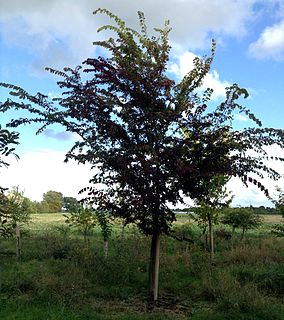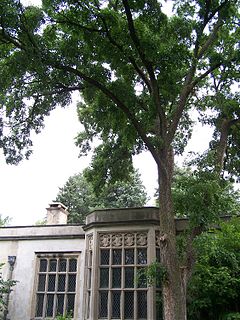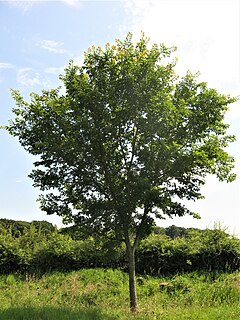| Ulmus parvifolia 'Frosty' | |
|---|---|
 'Frosty' leaves. | |
| Species | Ulmus parvifolia |
| Cultivar | 'Frosty' |
| Origin | US |
The Chinese Elm cultivar Ulmus parvifolia 'Frosty' was intended primarily as a dwarf variety.
| Ulmus parvifolia 'Frosty' | |
|---|---|
 'Frosty' leaves. | |
| Species | Ulmus parvifolia |
| Cultivar | 'Frosty' |
| Origin | US |
The Chinese Elm cultivar Ulmus parvifolia 'Frosty' was intended primarily as a dwarf variety.
The tree is distinguished by its small leaves, which rarely exceed 18 mm in length and feature irregular white margins.
The species and its cultivars are highly resistant, but not immune, to Dutch elm disease, and unaffected by the Elm Leaf Beetle Xanthogaleruca luteola . [1]
'Frosty' is relatively common in cultivation on both sides of the Atlantic.
Widely available.
Widely available.

The Wych Elm cultivar Ulmus glabra 'Camperdownii', commonly known as the Camperdown Elm, was discovered about 1835–1840 as a young contorted elm growing in the forest at Camperdown House, in Dundee, Scotland, by the Earl of Camperdown's head forester, David Taylor. The young tree was lifted and replanted within the gardens of Camperdown House where it remains to this day. The original tree, which grows on its own roots, is less than 3 m tall, with a weeping habit and contorted branch structure. The earl's gardener is said to have produced the first of what are commonly recognised as Camperdown elms by grafting a cutting to the trunk of a wych elm.

Ulmus rubra, the slippery elm, is a species of elm native to eastern North America, ranging from southeast North Dakota, east to Maine and southern Quebec, south to northernmost Florida, and west to eastern Texas, where it thrives in moist uplands, although it will also grow in dry, intermediate soils. Other common names include red elm, gray elm, soft elm, moose elm, and Indian elm. The tree was first named as part of Ulmus americana in 1753, but identified as a separate species, Ulmus rubra, in 1793 by Pennsylvania botanist Gotthilf Muhlenberg. The slightly later name U. fulva, published by French botanist André Michaux in 1803, is still widely used in dietary-supplement and alternative-medicine information.

Ulmus szechuanicaFang, known as the Szechuan (Sichuan), or red-fruited, elm, is a small to medium deciduous Chinese tree found along the Yangtze river through the provinces of Sichuan, Jiangxi, Anhui, and Jiangsu.

Ulmus 'Frontier' is an American hybrid cultivar, a United States National Arboretum introduction derived from a crossing of the European Field Elm Ulmus minor with the Chinese Elm Ulmus parvifolia in 1971. Released in 1990, the tree is a rare example of the hybridization of spring- and autumn-flowering elms. Tested in the US National Elm Trial coordinated by Colorado State University, 'Frontier' averaged a survival rate of 74% after 10 years.

Ulmus 'Homestead' is an American hybrid elm cultivar raised by Alden Townsend of the United States National Arboretum at the Nursery Crops Laboratory in Delaware, Ohio. The cultivar arose from a 1970 crossing of the Siberian Elm Ulmus pumila with the hybrid N 215, the latter grown from seed sent in 1960 to the University of Wisconsin-Madison elm breeding team by Hans Heybroek of the De Dorschkamp Research Institute in the Netherlands. Tested in the US National Elm Trial coordinated by Colorado State University, 'Homestead' averaged a survival rate of 85% after 10 years. 'Homestead' was released to commerce without patent restrictions in 1984.

The hybrid elm cultivar Ulmus × hollandica 'Pioneer' is an American clone arising from the crossing of two European species, Wych Elm U. glabra and Field Elm U. minor. Raised by the USDA station at Delaware, Ohio, in 1971, 'Pioneer' was released to commerce in 1983.

Ulmus 'Morton' is an elm cultivar cloned from a putative intraspecific hybrid planted at the Morton Arboretum in 1924, which itself originated as seed collected from a tree at the Arnold Arboretum in Massachusetts. Although this tree was originally identified as Ulmus crassifolia, it is now believed to have been a hybrid of the Japanese elm and Wilson's elm. Accolade has proven to be the most successful cultivar tested in the US National Elm Trial, averaging a survival rate of 92.5% overall.

Ulmus 'Morton Glossy' is a hybrid cultivar raised by the Morton Arboretum, Illinois. Originally named 'Charisma' until it was realized that name had already been registered for another plant, the tree was derived from a crossing of two other hybrid cultivars grown at the Morton: Accolade and Vanguard. Tested in the US National Elm Trial coordinated by Colorado State University, Triumph averaged a survival rate of 86% after 10 years. Triumph was introduced to the UK in 2006 by the Frank P. Matthews nursery in Worcestershire.
Ulmus 'Morton Plainsman' is a hybrid cultivar raised by the Morton Arboretum from a crossing of Siberian Elm and a Japanese Elm grown from openly pollinated seed donated by the Agriculture Canada Research Station at Morden, Manitoba. Tested in the US National Elm Trial coordinated by Colorado State University, Vanguard averaged a survival rate of 78% after 10 years.

Ulmus 'Morton Red Tip' is a hybrid cultivar raised by the Morton Arboretum from an open pollination of Accolade. The tree has occasionally been reported as a hybrid of Accolade with the Siberian Elm Ulmus pumila, an error probably owing to the commercial propagation of the tree by grafting onto U. pumila rootstocks. Tested in the US National Elm Trial coordinated by Colorado State University, Danada Charm averaged a survival rate of 77.5% after 10 years.

Ulmus 'Morton Stalwart', is a Morton Arboretum hybrid cultivar arising from a controlled crossing of Accolade with the hybrid of a Field Elm U. minor from eastern Russia and a Siberian Elm U. pumila. Tested in the US National Elm Trial coordinated by Colorado State University, Commendation averaged a survival rate of 85% after 10 years.

The American Elm cultivar Ulmus americana 'New Harmony' was raised by the Maryland Agricultural Research Service and released by the United States National Arboretum in 1995, along with 'Valley Forge'. 'New Harmony' proved the most successful U. americana cultivar in the US National Elm Trial, averaging a survival rate of 85.5% overall.
The Chinese Elm cultivar Ulmus parvifolia 'Dynasty' is a United States National Arboretum introduction reputed to be very fast-growing.
The Chinese Elm cultivar Ulmus parvifolia 'Hallelujah' is one of three American introductions made circa 1992 that were selected for their cold hardiness. 'Hallelujah' is known to have withstood -37°C (-35°F) in Missouri.
The Chinese Elm cultivar Ulmus parvifolia 'Geisha' is a dwarf variety.

The Japanese elm cultivar Ulmus davidianavar.japonica 'Prospector' was originally treated as a cultivar of Wilson's elm U. wilsonianaSchneid., a species sunk as Ulmus davidiana var. japonica by Fu. A U.S. National Arboretum introduction, it was selected in 1975 from a batch of 1965 seedlings in Delaware, Ohio, and released without patent restrictions in 1990. 'Prospector' proved moderately successful in the US National Elm Trial, averaging a survival rate of 76% overall.

The 'dwarf' elm cultivar Ulmus 'Jacqueline Hillier' ('JH') is an elm of uncertain origin. It was cloned from a specimen found in a private garden in Selly Park, Birmingham, England, in 1966. The garden's owner told Hillier that it might have been introduced from outside the country by a relative. Hillier at first conjectured U. minor, as did Heybroek (2009). Identical-looking elm cultivars in Russia are labelled forms of Siberian Elm, Ulmus pumila, which is known to produce 'JH'-type long shoots. Melville considered 'JH' a hybrid cultivar from the 'Elegantissima' group of Ulmus × hollandica. Uncertainty about its parentage has led most nurserymen to list the tree simply as Ulmus 'Jacqueline Hillier'. 'JH' is not known to produce flowers and samarae, or root suckers.

The Chinese Elm cultivar Ulmus parvifolia 'Seiju' is a dwarf variety, a sport of 'Hokkaido'.

The Chinese Elm cultivar Ulmus parvifolia 'Yatsubusa' is a dwarf variety.
The Chinese Elm cultivar Ulmus parvifolia 'Garden City Clone' was raised in Kansas. The champion tree was 18 m tall in 1993; however, the name 'Garden City Clone' is not officially recognized.